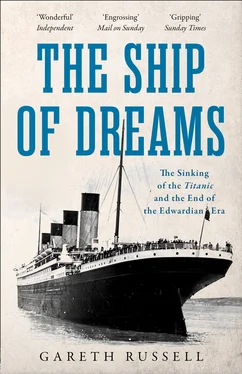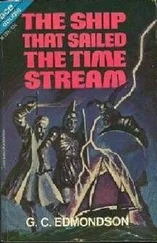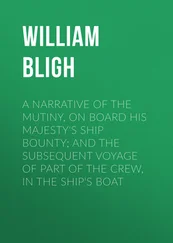By the turn of the century, many of the children and grandchildren of the plutocratic pioneers had sought to beautify and perhaps exorcise their legacy with a gilding borrowed from the once rejected hierarchies across the Atlantic. Palatial homes were built in imitation of the Trianon, Grand and Petit, albeit with modern plumbing, wiring and far better heating. The tribe was demarcated with rules as rigid as Habsburg Spain’s and a similar sense of worth. One of the Astors boarding the Titanic was a son of the famous socialite whose ballroom’s capacity of 400 had set the parameters of what constituted polite New York Society, known thereafter as ‘the Four Hundred’ – ‘If you go outside that number you strike people who are either not at ease in a ballroom or else make other people not at ease,’ explained one member of the sacred band. In that rarefied milieu, Mrs Astor had been compared by one admirer to Dante’s version of the Virgin Mary in The Divine Comedy , only here the ‘circulated melody’ surrounding the blessed lady was the Manhattan elite rather than the heavenly host, and the sparkle of the twelve celestial stars in the Virgin’s crown had been replaced by so many family diamonds that Mrs Astor was likened to a chandelier by a guest at one of her annual January balls. There she greeted guests sitting in a throne-like chair before a life-size portrait of herself, with her Fifth Avenue mansion staffed by footmen dressed head to toe in a livery inspired by those worn by the British Royal Family’s servants at Windsor Castle.[9] The fashions, sports and manners taught at Eton, Harrow and Winchester were imported and applauded, as were countless art treasures which were bought, shipped and quite probably saved from crumbling European palazzos, manors, castles and monasteries.
Following the Anglophile trend had come easily for John Thayer. Both he and his wife Marian, ten years his junior, were scions of old-money families from Philadelphia, America’s first capital, where Society predated the War of Independence. There had been born a class that would later jokingly be dubbed the acronymic WASPs, since they were all white and nearly all Anglo-Saxon Protestants. Thayer’s life had played out along the paths paved by this self-created aristocracy, beginning with prep schools and then an Ivy League education, where he had excelled at lacrosse. His summers had been divided between the family’s main home on the outskirts of Philadelphia and their sprawling mansion-sized cottage by the beach. He had pursued his love of cricket at their local club, Marion, in Haverford, which he represented in 1884 on a team sent to compete in England. That trip had apparently solidified Thayer’s belief that it was only in Europe that one could learn the ‘correct’ way of doing things. After he and Marian Morris married in 1893, jaunts across the Atlantic had become a regular part of their annual routine. That year, they had been accompanied by their eldest son, John Thayer III, known as ‘Jack’ in the family.[10] Seventeen years old, tall, blond, athletic and an excellent swimmer, Jack was sitting next to his parents on the Nomadic , returning to his three younger siblings and home, where as a student of the nearby Haverford School he would begin the application process for Princeton, after which he would be sent back to Europe for a few years of apprenticeship in private banking. In his words, ‘It could be planned. It was a certainty.’[11]
As the Nomadic and the Traffic made their way slowly towards the arriving Titanic , Tommy Andrews watched from the deck, anxiously inspecting their progress. A year earlier, the White Star Line had retired their antiquated tenders in favour of new constructions from Harland and Wolff to service the Olympic ’s maiden stop at Cherbourg.[12] Relieved that the ferries still seemed to be working as expected, Andrews went back to his cabin to pen a brief letter to his wife, containing the observation, ‘We reached here in nice time and took on board quite a number of passengers. The two little tenders looked well, you will remember we built them a year ago. We expect to arrive at Queenstown about 10.30 a.m. to-morrow. The weather is fine and everything shaping for a good voyage.’[13]
The Titanic arrived just at the dying of the afternoon light with the sun setting behind her, and by the time of the last embarkation the liner’s decks, windows and portholes were illuminated against the night. As they approached, Edith Rosenbaum, an American fashion journalist returning from the Paris spring shows, observed, ‘In the dusk, her decks were 11 tiers of glittering electric lights. She was less a ship than a floating city, pennants streaming from her halyards like carnival in Nice.’ One of the Astors opined, ‘She’s unsinkable. A modern shipbuilding miracle.’[14] The Nomadic ’s passengers gazed up at a ship weighing just over 46,000 tons, nearly 883 feet long and 92 feet wide, rising roughly to the height of an eleven-storey building beneath four funnels, their top quarters painted black and the rest in the buff yellow that constituted the White Star Line’s livery.[15] The last of those funnels was a dummy, used for ventilation, obviating the need to build as many on-deck ventilation shafts as were required on other ships. This decision by Andrews and his team had helped create in the Titanic and her sisters three extraordinarily elegant ships. They had more in common with the smooth lines of the private yachts of European royalty than with their often bulky commercial rivals. Particularly when seen in profile, the Olympic -class liners were blessed with a clean and appealing gracefulness, a fact frequently praised in shipbuilding journals and contemporary travel guides.[16] The earliest designs for the Titanic had apparently suggested only three funnels, but the White Star Line concluded that four were indelibly associated with great ships in the travelling public’s mind, thanks largely to a class of ships that had emerged from the Thayers’ last stop before Cherbourg.[17]
*
Prior to boarding the Titanic , John Thayer and his wife had spent some time visiting Berlin as guests of both the US Consul General, Alexander Montgomery Thackara, and the new American Ambassador, John Leishman, who had previously served as the US representative to Switzerland, the Ottoman Empire and Italy. Although it had existed for hundreds of years as Prussia’s capital, as Germany’s Berlin remained new, high on hustle and low in majesty, with most traces of the provincial capital vanishing in pursuit of modernity. Berlin, like Belfast, seemed ever expanding; Mark Twain had once quipped, ‘Next to it, Chicago would appear venerable.’[18] Nonetheless, it was European and, like Thayer, Leishman was persuaded of the European way of doing things, at least when it came to manners if not to business. Unhappily, by the time the Thayers arrived as guests of the embassy the Ambassador had run aground on some of the Old World’s less appealing attributes. His eldest daughter had already married a French count when her younger sister, Nancy, received a proposal from the Prince von Croÿ, who was in the happy and increasingly unusual position of possessing both a fortune and a pedigree like Midas’. Nancy, as an American and a commoner, was counted as defective on two fronts by the Prince’s formidable aunt, the Archduchess Isabella of Austria and in her crusade to prevent the nuptials, the Archduchess enlisted the help of the German Kaiser, who was traditionally required to give his blessing to the marriage of a subject as high-ranking as von Croÿ.[19] This the Kaiser declined to give, causing a rupture with the American Ambassador, who was understandably mortified by the insult to his daughter. As the newspapers buzzed with the scandal, relations between the Kaiser and the Ambassador deteriorated to the extent that, after Nancy and the Prince married without imperial permission in October 1913, Leishman felt he had no choice but to resign.[20]
Читать дальше












